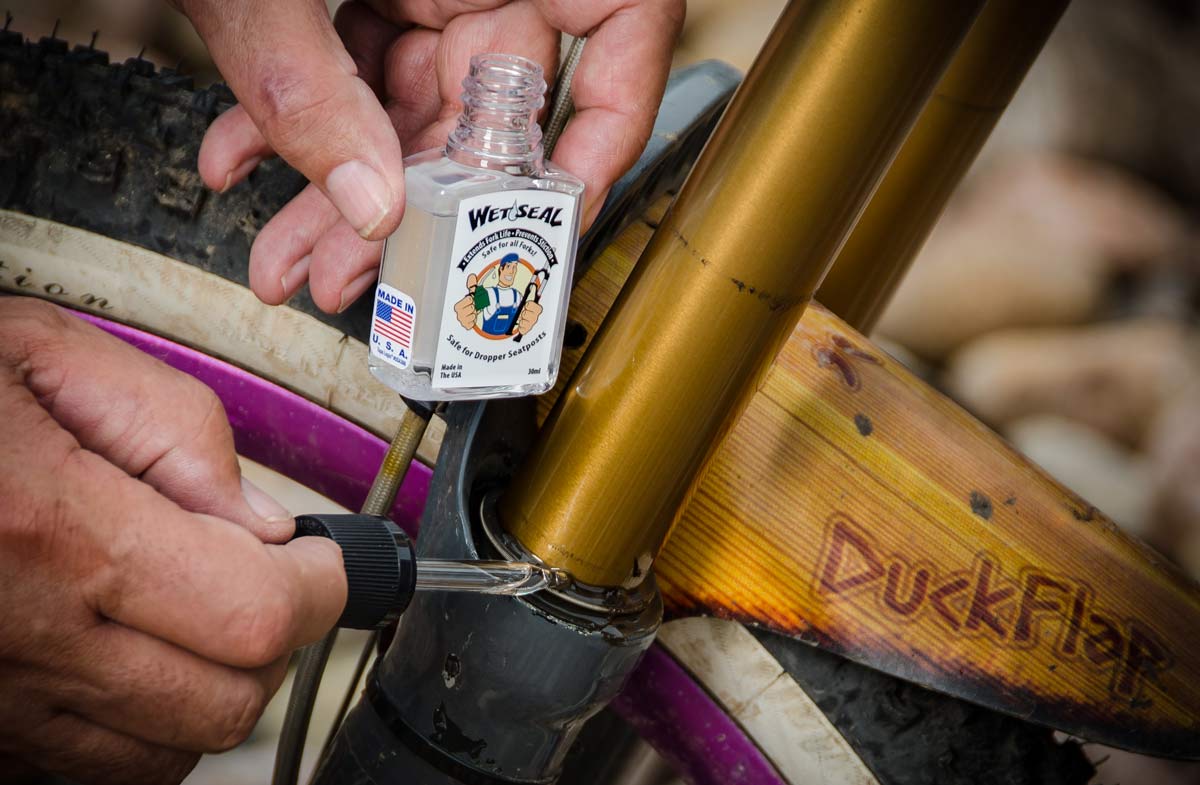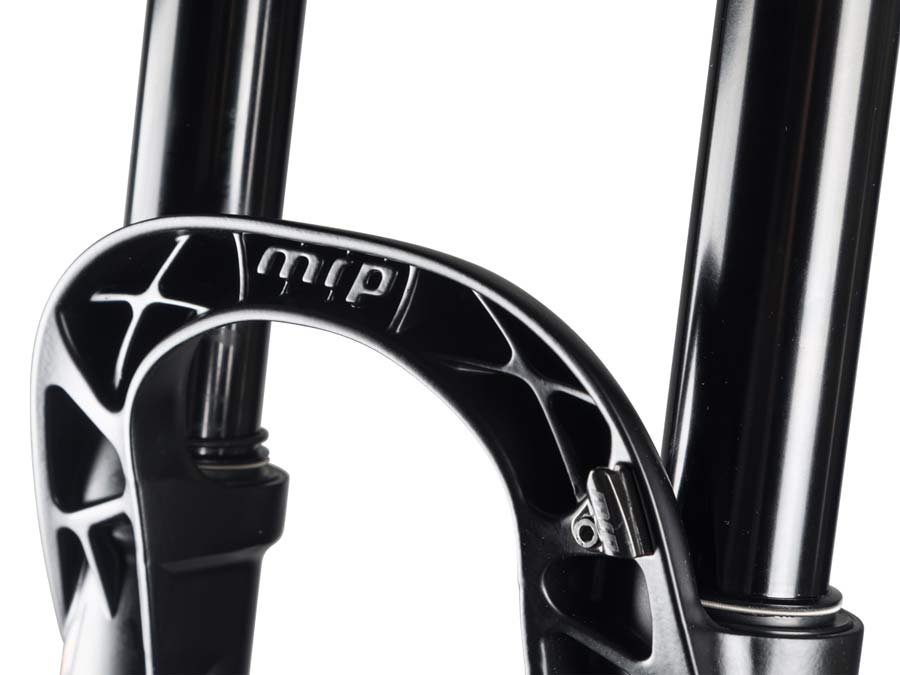This week’s installment deals with maintenance. Superficial maintenance. Which is perhaps the easiest kind of maintenance, which means it’s sometimes overlooked or undervalued. Or maybe it doesn’t matter. We wondered if you needed to clean and lube your fork stanchions, or if the sliders and built in oil sponges beneath them provided all of the care your fork needs.
For answers, we reached out to a number of suspension manufacturers and lubrication companies who make aftermarket care products to see what they’d say. Here are responses from Rockshox, MRP, Muc-Off and Wet Seal, which don’t necessarily agree with each other. So, take it all in and use your judgement as to what works best for your riding conditions and maintenance routines…
BIKERUMOR: Should you lube your fork stanchions? Why or why not?
ROCKSHOX: At RockShox, we recommend cleaning and inspecting your stanchions every ride and performing your lower leg service after every 50 hours of use.
Cleaning the stanchions removes any dirt and debris from the surface that the dust wiper seal keeps out of the fork with every compression. This extends the life of your dust wiper seals, minimizes damage to upper tubes, and minimizes lower leg contamination.
Applying lubrication to the stanchions will attract dirt and debris, which the wiper seal will wipe away upon the next compression, creating a ring of oil and debris that will need to be cleaned before your next ride. With routine 50 hour lower leg service, the fork will provide the necessary lubrication to the stanchions to perform properly until the next service interval is reached. Routine service combined with proper cleaning and inspection can extend the life and performance of your suspension product.
MRP: We don’t recommend lubing your stanchions or rear shock shafts simply because it shouldn’t be necessary. If doing so results in a noticeably better feel to either, they’re likely overdue for service and running dry internally. It’s like treating a symptom, not the underlying illness. Furthermore, the lube applied externally is likely to attract dust.
WET SEAL: Yes. One can imagine their stanchions are penetrating their lowers. Given it’s a tight fit, lube will reduce the heat on your forks’ seals as the result of friction. Without using lube, seals prematurely wear resulting in dirt/grime finding it’s way into the bath system. The space between the seals and the stanchions is extremely minute to prevent foreign particles from entering your lowers. Seals are the major line of defense for keeping them out. Ensuring that stanchions/seals are properly lubed will extend the life and performance of your fork.
MUC-OFF: Keeping your fork stanchions well lubricated is vital as it reduces the stiction between the wiper seal and the stanchion, which improves small bump sensitivity and trail buzz as the stiction is dramatically reduced. It also helps to keep dirt off the stanchion and seals as the silicon repels dirt and grime to the surfaces cleaner and hence reduces the risk of contaminants getting into the wiper seal (and in turn your fork oil).
BIKERUMOR: If so, how often?
ROCKSHOX: You should clean and inspect your stanchions and dust wiper seals before or after every ride.
WET SEAL: This depends on how often you ride, where you’re riding and the manufacturer of your fork. We recommend applying Wet Seal once every three rides. If you ride in a dry desert/dusty climate, you may find it beneficial to apply before every ride. Seals in dry climates are prone to cracking if not looked after.
MUC-OFF: Re-apply before each ride for best results and maximum protection.
BIKERUMOR: What’s the best way to clean them first?
ROCKSHOX: Clean your stanchions and dust wiper seals before or after every ride with a clean, lint-free towel and isopropyl alcohol as necessary. In addition, if your suspension product has a sag measuring o-ring, it is recommended to keep that clean and free of dirt and debris as well.
MRP: We recommend cleaning your seal areas with a mild soap and water mix periodically, sooner rather than later if there is significant dirt build up.
WET SEAL: A clean, dry Micro-Fiber rag works best. If you’re having trouble getting heavy grease off the seal or stanchions, we recommend using a little bit of water on the micro-fiber rag. DO NOT USE SOAP. Soap will break down the good oils and grease inside your fork which can result in needing an entire rebuild.
MUC-OFF: Start by hosing down thoroughly to remove any dirt but do not force water into the seals. Our Nano Tech Bike Cleaner can be used to remove any stubborn grime and then rinsed and dried with a clean cloth. You can then apply a light coating of Silicon Shine around the stanchion/wiper seal and you are good to go.
BIKERUMOR: What product or type of lubrication should you use?
ROCKSHOX: For 50 hour lower leg services, our service manuals communicate the proper procedures and the specific grease and oils, including quantities, necessary for each model of fork. These can all be found at sram.com/service. The specific grease and oil requirements for each fork are also available in the Front Suspension Specifications documents available for each model year.
MRP: In addition to cleaning the stanchions, regularly changing the bath oil in your lowers, lubricating your seals internally with Slick Honey, and replacing seals as needed should be all you need to do keep your suspension feeling fresh.
WET SEAL: Our product Wet Seal was the first lubricant introduced to the industry specifically for suspension forks and this article. In 2014 we had the Suspension Experts in Asheville run a serious of tests on every fork to make sure our formula was 100% safe.
MUC-OFF: We recommend our Silicon Shine.
BIKERUMOR: Is there any product/type of lube you should NOT use?
ROCKSHOX: Only use the RockShox branded oils and lubricants that are specified for your fork, unless another brand is specifically communicated. These oils and lubricants have been created, tested, and confirmed to be compatible with the seals and components in RockShox forks. Other non-specified oils and lubricants may not be compatible with RockShox suspension components and could cause damage, voiding the product’s warranty.
WET SEAL: There are Fork Stanchion lubricant “sprays” on the market. We do NOT recommend using sprays or aerosol cans as an applicator. It’s difficult to regulate the amount of liquid that’s extracted- BUT far worse is the risk of the liquid spray getting on the brake pads or brake rotor. If the liquid gets on brake pads, they will have to be thrown out. The brake rotor will also have to be submerged into a bucked of dish washer soap, cleaned, then submerged into a bucket of rubbing alcohol. -Even then, we’d recommend replacing the rotor.
We don’t recommend using water-based lubes. Water dries and tends to leave a residue. They’re cheaper to make and in an effort to make the water-based lubricant last longer, manufactures will use Paraben (a wax) so the water binds and holds the other ingredients. However, this wax is known to grab outside particles because of its “sticky” nature. It also won’t be long-lasting.
Typically you want to use a lubricant that has a similar composition of what’s found in the bath system.
MUC-OFF: We would not recommend using any other kind of lube apart from a Silicon-based specific formula, which has been designed for suspension systems. Many other lubes could actually attract more dirt and grime and their thicker viscosity could actually make the stiction a lot worse!
BIKERUMOR: Does the same apply for rear shocks?
ROCKSHOX: Yes. Clean and inspect the shock damper body before or after every ride with the same procedure; use a clean, lint-free towel and isopropyl alcohol as necessary. This will extend the wiper seal lifespan, minimize damage to the shock damper body, and minimize air can contamination.
Applying lubrication to the damper body will attract dirt and debris, which the wiper seal will remove upon the next compression, creating a ring of oil and debris that will need to be cleaned prior to your next ride. The wiper is designed to keep dirt and debris out, not pull lubrication in. Performing the routine 50-hour air can service will provide the necessary lubrication for the shock to perform as designed until the next service interval is reached.
WET SEAL: Rear shocks are a little different. The mechanism uses smaller parts and less internal oil/air than a fork, therefore it needs fewer applications of Wet Seal. That’s not saying that seals won’t dry up on a rear shock, but they will dry up less because of the configuration of rear shocks. The seals on rear shocks are also larger and does a better job of dissipating heat. We recommend applying two drops of Wet Seal to the rear shock seals once every dozen or so rides.
MUC-OFF: Yes, our Silicon Shine is ideal to use on both the front and rear shocks.
BIKERUMOR: Anything else you’d like to add on this subject?
ROCKSHOX: Performing routine service at the scheduled intervals will have the greatest impact on maintaining suspension’s performance and extending life span. The above cleaning procedures and 50 hour service intervals also apply to the Reverb seatpost. All of RockShox’s service intervals can be found here: RockShox Service Intervals. Riders who frequent bike parks, extreme terrain, or encounter severe environmental conditions will benefit from more frequent service.
MRP: One tip we do recommend is to occasionally flip your bike over to allow the bath oil accumulated at the bottom of your lowers to wet your bushings and seals. If there is a sufficient amount of oil in there, it should splash around as the fork cycles anyway, but to expedite that process and make your fork feel fresh on the first hit, do the above.
WET SEAL: Our Wet Seal also works great on Dropper Posts. If you find that your dropper post is slow to rise or won’t rise at all but has proper air pressure, Wet Seal will have that post popping up like a hen at sunrise. Similar when applying Wet Seal to your fork, clean the dropper stanchion and seal with a micro-fiber rag before applying our product. Once applied, drop and rise the post 3-4 times and clean off the remaining liquid and grime with a micro-fiber rag.
MUC-OFF: Yes! You can’t beat regular cleaning of your whole bike to reduce wear and tear and use a good protectant all over your bike! We wash our bikes after every ride, little and often is better than waiting and turning it into a hellishly big job!
Your suspension fork is typically the most expensive component on your bike, so cleaning the bike each time you ride makes bike cleaning a quicker task than waiting until your bike is grinding itself to early death and the dirt is much harder to remove! If you also spray Silicon Shine on your frame and components (covering braking surfaces!) it will mean cleaning is so much faster as the surface tension between the dirt and the surface is drastically reduced while you are riding and cleaning so the dirt is removed with much less effort!
The fun never ends. Stay tuned for a new post each week that explores one small suspension tech, tuning or product topic. Check out past posts here. Got a question you want answered? Email us. Want your brand or product featured? We can do that, too.


